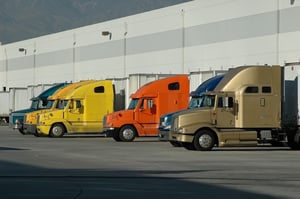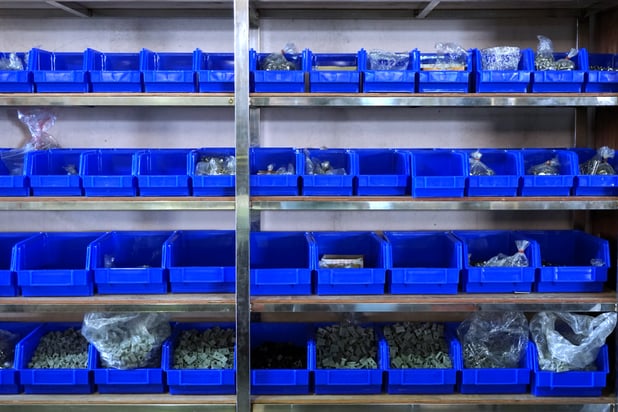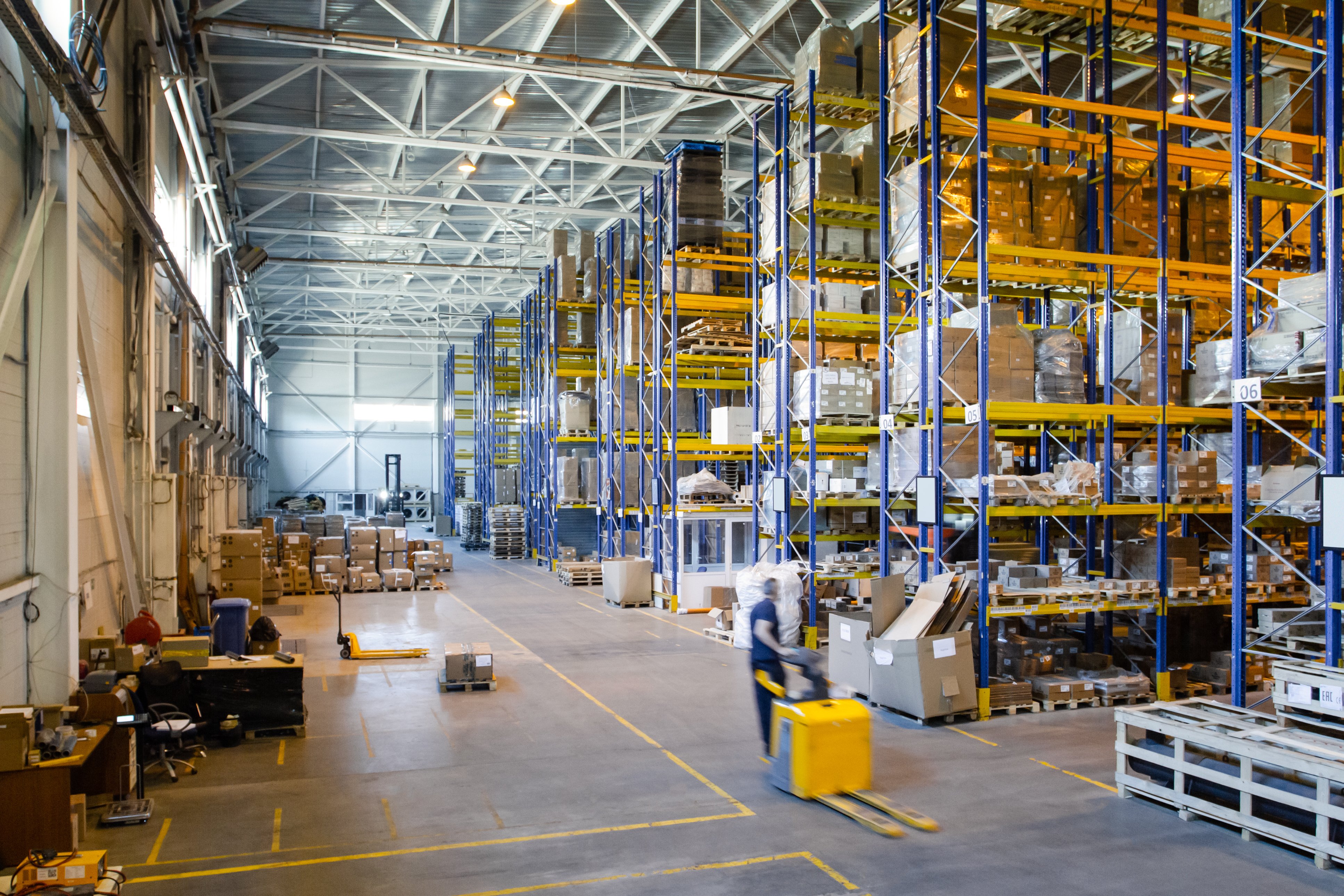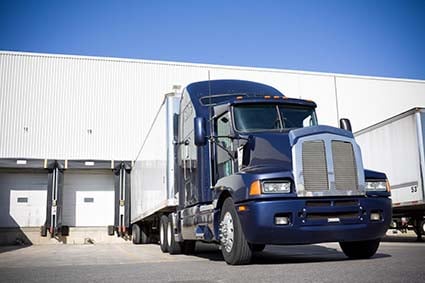
There are several basic principles that apply to warehouse layout design and running an effective distribution center operation. Without the proper layout and design of your distribution center, no matter the square footage, you will face capacity issues, decreased productivity, and storage inadequacies.
In this blog, we’ll discuss the 27 key principles that you should consider for warehouse layout design and productivity. Here are 27 considerations for effective warehouse design and operational efficiency:
1. Trends in distribution center facilities
If you’re looking to acquire an existing center or build a new center, it’s important to understand how trends in warehouse design have changed. Modern warehouse designs in the last ten years or so typically have clear spans between 24’ and 34’. Larger, automated centers with very narrow aisle and picking systems are now built to 45+ feet.
Older centers often have less than 24 feet clear span. The tradeoff is that older facilities will have larger footprints and lower ceiling clear span versus the higher clear span for more cubic height of storage with newer centers.
As real estate becomes more expensive and the existing warehouse market remains at capacity, it is important to calculate what the total warehouse storage capacity for an existing building is and the racking, automation and material handling equipment that will be required to take advantage of the higher clear span.
2. Distribution center facility costs
Considering the total cost per order for fulfillment, facility costs in total are in a range of at least 15% to 20%, depending on the market. These costs include:
- Leases or building ownership.
- Total occupancy costs (utilities, common area maintenance, taxes).
- Material handling and automation in the distribution center.
- Amortization and depreciation of systems and equipment.
3. Impacts on the cost of labor
An efficient layout can dramatically affect labor cost and productivity. Direct and indirect labor is typically more than 50% of the cost per order, excluding outbound shipping costs. Minimum wage in many states is climbing, but many companies are already at $18-$22 per hour.
Buildings that achieve the total square feet required but are chopped up into various sections are problematic and affect productivity. The same is true with very long, narrow warehouse versus more rectangular facilities. Reducing travel time is key and the wrong shape building will impact labor cost.
One of the key design considerations should be how labor hours can be saved in the layout and design, as well as systems and process. A number of recommendations below improve labor productivity. Also consider how automation can reduce labor costs and create high density storage - which will save space.
4. Storage space/cube
Make sure you are utilizing the potential storage space/cube of the distribution center. Ensure that vertical space, as well as individual location cubic capacity, is fully utilized. Maximize cube and ground level square feet with pallet rack and material handling equipment.
Square feet requirements for storage are directly impacted by the racking design. Most warehouses operate with one of the following racking designs:
- 12’ Standard Aisle Width – utilizes a traditional sit down/counterbalanced lift truck
- 9’ to 10’ - Narrow Aisle Width – utilizes a narrow aisle standup reach truck
- 6’ Very Narrow Aisle Width – utilizes a turret truck or swing arm truck design
Example of pallet storage by type, each of these options are discussed and illustrated below.
|
|
STANDARD 12’ AISLE |
NARROW 9’ AISLE |
VERY NARROW 6’ AISLE |
|
Pallets |
3,800 pallets |
5,050 pallets |
6,300 pallets |
|
% Increase |
|
33% |
66% |
One way that warehouses often make use of total cube is to install mezzanines over work areas and departments that do not require high cube. In larger centers, picking modules can be installed on above floor levels. These can greatly benefit operations by creating efficient warehouse processes and improving overall warehouse space utilization.
READ: 12 Considerations for Adding Space to Your DC Using Mezzanines
5. Slotting, replenishment, and location control systems
These three activities form the backbone of the operation and should be given appropriate attention. If they are cared for, much of the rest of the operation will run effectively. Understand how warehouse slotting affects your operations, as well as inefficiencies in inventory replenishment - these are critical areas that will improve your layout and design.
Proper warehouse slotting will ensure the correct size of stock locations that need to be planned for in your facility - this is heavily influenced based on the shape of items. With replenishments, some companies need to plan staging space when inventory is pulled from bulk before being put into primary locations.
6. Flexibility in the operation and layout
Planning for unknown future changes to the business or fulfillment model is vital to avoid unnecessary costs making unplanned changes to the facility and operation. Companies must be careful not to develop a layout or process that is inflexible or not scalable.
Certain automation and material handling equipment can limit flexibility in the design. Consider potential changes in product lines as well as purchasing patterns. Understand how these changes can impact your future design. Part of a well-designed warehouse layout is involving all departments to understand future changes.
READ: How to Develop an Effective Warehouse Layout Process
7. Congestion and interference
Avoid unnecessary congestion or overcrowding in the distribution center. The time lost due to overcrowding or congestion is significant. A well-designed slotting strategy will help to eliminate painful congestion in your warehouse operations.
Workflow efficiency is critical to a well-designed warehouse layout. The flow of inventory is as critical as the flow of people through the warehouse space. When considering the flow of materials, consider how equipment and people may come in contact with one another. Uninterrupted flow will sometimes require additional warehouse space to remain efficient.
8. Location storage media
Use a variety of location storage media for slotting and reserve as dictated by item cubic velocity. The “one size fits all” approach rarely works to maximize efficiency in space and labor performance.
Use your items cubic dimensions and weight to determine the pallet racking, shelving designs and types of material handling equipment. Consider high density automated storage systems to further reduce space requirements. These options greatly increase the use of the vertical clear height. Automated solutions also avoid inefficient routes and congested workflows.

9. Travel walking time
Since more than half of the total labor time in the distribution center is spent walking, any efforts to reduce travel distance and time will pay off in reduced labor costs. Effective layout and slotting processes can help reduce walking time. The warehouse payout and method of picking must be considered.
A good warehouse management system (WMS) will allow your company to develop efficient processes. A WMS can help to interleave various tasks to gain the most efficiency in your warehouse layout and design.
READ: Selecting the Best Picking Method for Your Business
10. Conveyors and automation for transport of product
Whenever possible, using a simple transfer conveyor system can improve operating efficiencies by reducing handlings and walk time. Make sure the cost of the equipment is justified. Conveyor selection is based on the size and weight of the product and the throughput volume. Accumulation has to be planned for in any conveyor design.
Consider how the use of autonomous mobile robots and (AMR) and automated guided vehicle (AGV) for improving the flow of materials in the design process. This can help to reduce congestion as well as unnecessary movements in labor for smooth operations.
11. Accumulation and storage space
Provide adequate accumulation and storage space on docks. Inefficiencies caused by lack of space on docks gets the operation off to a bad start. It not only causes inefficiencies in the operations on the dock, but it’s negative effects ripple down to other distribution center functions.
This is usually one area that companies begin to squeeze down when capacity is a problem. This can make inventory management difficult on the docks, as well as erode efficient operations on the docks. A well-designed layout will provide efficient space for growth over time.
12. Number of dock doors and loading dock space
Older facilities tend to have a shortage of dock doors for efficient operations. Modern warehouse design typically maximizes the number of dock doors in a facility.
If you are looking to improve an older facility, focus on improving the loading dock doors on both the inbound and outbound sides of the operations. This increased space will greatly improve material movement in and out of the facility, as well as into storage.
Whether using pallet jacks or forklifts, consider the impacts of people and equipment. Again, if you undersize the dock doors and space, you can create safety risks.
Additionally, if the space for inventory processing or a more complex process like inspection etc. on the inbound side is too small, this will hurt efficiency.
13. Cross docking
Consider using cross docking for backorder processing as the item is received. The ability to omit steps in the fulfillment process and take receipts directly to the packing/shipping function will save time.
An efficient warehouse design seeks to eliminate duplicate touches and unnecessary steps to process the order volumes.
14. Barcodes
Use barcodes as much as possible. Consider a warehouse management system (WMS) to reduce labor and improve efficiency in as many areas of the fulfillment process as possible. The data available will help to improve labor costs, identify bottlenecks and better utilize space overall.
15. Open storage space
Keep at least 15% - 20% of locations open and available. This may not be possible all of the time but having space available to store inventory in picking and reserve locations is a key factor.
Once a facility exceeds 80-85% of the useable storage for extends periods, the facility is deemed as full. The reason is that it leads to handling inventory multiple times as inventory may not always be in the most optimal location.
Additionally, when the pallet racks and aisles are full, companies will stage in the aisleways. This increases safety risks and traffic flow. An efficient warehouse layout design will factor in inventory, SKU and order growth.

16. Productivity reporting
Most employees want to know what’s expected of them and how they are measuring up to those expectations. Measure and report productivity in the warehouse to improve performance.
The average warehouse typically has some level of reporting and metrics available. However, most could benefit from additional metrics and benchmarking.
This data is critical for understanding operational efficiency, workflow efficiency, customer satisfaction, and proper storage utilization.
17. Product volume
Move as much product as possible at one time. Maximizing the product per trip will reduce the total trips and time required. Applications can be found in the picking, put away, replenishment, etc. distribution center functions. Avoid a poor warehouse layout which relies on an inefficient flow of materials and extra touches.
18. Slotting procedures
Maintaining slotting procedures are critical to an efficient center. Try to provide primary pick space for one week’s average unit sales for each SKU. Focus on the top 10% of fast selling SKUs to ensure that they are properly slotted. Make sure the slotting process is maintained as a dynamic, ongoing process. Slotting will ensure efficient flow and sufficient space for storage, both helping to lower operating costs.
READ: How to Improve Your Warehouse Slotting
19. Well-designed pack station
Since the majority of distribution center labor is spent in the packing function, it makes sense that a well-designed pack station can save you time and money. Ensure that all of the required materials are available for the packer and that adequate workspace is provided.
Optimal efficiency in a well-designed warehouse layout keeps packers at their stations with plenty of packing materials to support the volumes. Additionally, packing tools such as suggested box size will gain further efficiency. Conveyor belts bringing picked orders to packers, and taking away orders ready to ship, will build efficiency.
Consider ergonomic principles when designing pack stations. Provide sufficient room for working, while minimizing reach and bending, or excessive lifting that may cause injuries.
20. Shift start times
Make sure that your schedule for distribution center staff coincides with work being available. This may involve staggering shift start times. Consider off shift activities to minimize interference with other distribution center functions.
An example of this is beginning picking and getting ahead of picking before bringing in packers who may not have work ready. This will help reduce bottlenecks in the operations as it fluctuates with customer demands.
21. 80–20 rule
The 80-20 rule (also known as the Pareto Principle) indicates that 20% of your SKUs usually account for 80% of your unit sales. As such, these popular items should be processed as efficiently as possible. Create a “Hot Pick” zone for the fastest sellers and reduce picker travel time.
The 80-20 rule applies to more than just picking. You must think about how this affects receiving, putaway, and replenishments. Additionally, consider that roughly 80% of the problems are going to come from 20% of the transactions, SKUs and other movements.
READ: Establishing and Running a "Hot Pick" Zone in Your Distribution Center
22. Single line orders
Batch-pick singles as much as possible. Single line orders may be more than 50% of orders in some distribution centers. By maximizing efficiency on these picks, operations can gain efficiencies and reduce the overall pick path by using hot pick zones, and cross - docking inventory.
23. Warehouse automation in the design process
Provide for the level of automation that can be cost-justified based on your particular operation and cost structure. Look for at least an 18-month to 36-month payback as a guideline.
Warehouse automation can provide the greatest space utilization and density of inventory in the design process. Automation of all types can be the most valuable asset in terms of labor savings and space use. Consider how the following types of warehouse automation can benefit your operations:
- Co-bots and Goods to Robot piece picking to support pickers in consumer and small B2B order fulfillment.
- Goods to person technologies to support picking operations - such as Opex Perfect Pick or Infinity or Swisslog AutoStore.
- Vertical Lift Modules (VLMs) to support a wide range of environments from critical spare parts to consumer picking and high security items.
- Shipping automation including weigh in motion, dimensioning and print and apply for shipping labels.
- Autonomous mobile robots (AMRs) and automated guided vehicles (AGVs) to support movements such as picking, inventory transfers and bulk movements.
- Automated Storage and Retrieval Systems (AS/RS) for bulk storage to picking options.
These are just a few examples of automation that can greatly improve operational efficiency in a well-designed warehouse layout design. Automation combines speed with accuracy to ensure customers receive the correct item. Improving these daily tasks will build a strong foundation going forward.
24. Flow charts and standard operating procedures
Develop process flow charts that track inbound product flow (a receipt through the put away process) and outbound customer orders (from replenishment to shipping), showing the path and number of times the product is touched. Eliminate touches to save labor costs and increase throughput and accuracy. From here companies need to:
- Develop strong Standard Operating Procedures (SOPs) that reflect the required processes, communications and system use.
- Document the SOPs for training purposes, including training videos, tests and quizzes.
- Reinforce training and improvements with teams and departments.
25. Staff involvement
Involve your distribution center staff in decision making relating to facility layout or operations planning. Those closest workers to the process usually understand it best. This is the perfect way to improve customer satisfaction in the operations.
Creating this environment for employees allows them to have a voice in the process and take ownership. A poor warehouse layout can make strong improvements by embracing this process, increasing traffic flow and eliminating unnecessary movements.
Distribution center activities, storage requirements and logical flow between functional areas can all be improved with employee feedback.
26. Lighting levels
Make sure that you provide adequate lighting levels based on the functions to be performed. Do not let existing light fixture locations determine where aisles between shelving, flow racks and racking are located. Poor lighting not only reduces morale but can contribute significantly to human errors.
Picking light levels are higher, where storage requirements are often less. Work activities like picking, packing, shipping, and pre-pack require a minimum of 50 to 75-foot candles of light. Bulk storage areas require 30 to 15-foot candles for equipment operators. A production process can require more lighting if it is human intensive compared to that of fully automated processes.
The ROI on improved lighting with LED lowers operating costs by reducing the overall energy costs.
27. Quality inspection and staging
Proper quality inspection, QA and testing is critical to ensuring the warehouse or distribution center eliminate downstream errors. Planning for the appropriate inspection level based on quality requirements also means ensuring the right amount of space in your facility.
The level of inspection needs to take into account new SKU growth and new vendors coming onboard. Companies often reduce these areas when space becomes a premium in the facility. Constraining these areas will lead to significant bottlenecks. High-demand items will heavily influence the space requirements.
Summary
When planning a well-designed warehouse layout, the physical layout and facility are only one aspect to consider. Workflow, processes and how labor is used are important considerations in an effective warehouse design. Utilizing a warehouse design consultant can greatly improve your operational performance.
READ: Are You Maximizing Your Warehouse Capacity and Efficiency?






SHARE